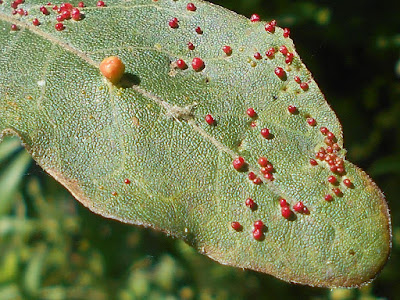'Sounds like a couple of jays,' remarked a passer-by.'
I hadn't the heart to tell him that it was just a couple of grey squirrels quarrelling over territories. Jays certainly sound rather similar and are far more interesting. He went on his way, walking his little dog, happy at having 'heard' these colourful corvids.
My first target was the pond. It is only a little feature; on a good day following heavy rain it has a surface area of maybe 15 square yards, but it is important and I hoped to record some water-loving insects.
The Meadowsweet, Filipendula ulmaria, was coming into flower. Odd to think that this plant, with its foaming mass of ivory-coloured flowers is a member of the rose family.
 |
The fragrance of meadowsweet can now be detected around the pond.
Stefen Hill Pocket park. 4 July, 2019
|
Today it was not receiving visitors but in a few weeks it may begin to develop some interesting galls. It will be joined in a few days by Purple Loosestrife, Lythrum salicaria. A few days ago I was discussing Yellow Loosestrife, with my friend Ann Pimm, but Yellow Loosestrife, an introduction from damp meadows in south-east Europe, is a member of the Primrose Family, Primulaceae. Purple Loosestrife is unrelated and belongs to the Lythraceae, a largely tropical family which includes, in the opinion of some botanists, the pomegranate.
However, I digress. I left the pond having found only a Woundwort Bug, Eysarcoris venustissima, laboriously - and rather pointlessly - climbing the trunk of an alder. Incidentally the epithet venustissima doesn't refer directly to the goddess Venus, but means 'graceful' or 'charming', so there is a sort of link.
However, I digress. I left the pond having found only a Woundwort Bug, Eysarcoris venustissima, laboriously - and rather pointlessly - climbing the trunk of an alder. Incidentally the epithet venustissima doesn't refer directly to the goddess Venus, but means 'graceful' or 'charming', so there is a sort of link.
 |
A woundwort bug clambers up an alder tree. Stefen Hill Pocket Park.
4 July, 2019
|
A few yards away a Field Maple, Acer campestre, was bearing some galls which merited scrutiny. The field maple is a close relative of the Sycamore, Acer pseudoplatanus, and both species are a martyr to galls. The field maple bore a scattering of the inevitable Aceria myriadeum, but it also bore a single, larger gall. It was Aceria machrochela, also common but less abundant.
 |
The larger Aceria machrochela surrounded by a myriad of A. myriadeum.
Stefen Hill Pocket Park. 4 July, 2019
|
A little further on and I was again faced with galls, this time on a willow tree. Willows form the genus Salix, and hold more galls than any other genus in Britain. This alone can make identification tricky: if the precise species of willow can be established then things are eased, but willows are promiscuous and frequently hybridise. Salicologists (yes, there is such a word) are easy to recognise: they are frequently bald, having torn their hair out with frustration.
The coalesced nature of these galls makes me as confident as I can be that they are the work of Iteomyia major, one of the gall midges.
The coalesced nature of these galls makes me as confident as I can be that they are the work of Iteomyia major, one of the gall midges.
 |
A willow leaf bears the galls of Iteomyia major. Stefen Hill Pocket Park.
4 July, 2019
|
And that was about it. A Silver-washed Fritillary seen from a distance proved, on getting closer, to be a Comma. But once again I returned home with a host of small fry for examination under the microscope. 'Nowt much...' begins the title of this blog but in fact it was a pleasant and informative visit.
No comments:
Post a Comment